Home » Other Articles » Going Loco Index » Going Loco - September 2022 - Going Loco - September 2022
Going Loco - September 2022
FRIDAY 30 SEPTEMBER
The Universal Saddle Bag? Part 2: All panniers GREAT and small.
Welcome back! Last time we took in the reasons for the existence of the pannier tank in the first place and how they became ubiquitous on the Great Western Railway. The small pannier became our end focus but there remains the pannier clad elephants in the room – the large panniers.
There were around ten different rebuilt classes of 15’ or larger wheelbase pannier tank engines that started life as either side or saddle tanks and had the Belpaire boiler/pannier tank makeover. One of the most famous is the 1076 class which were otherwise known as the Buffalo Class. There were 266 built between 1870 and 1881. They are unusual to our modern eyes as they have double frames. That means that they have a chassis comprised of an inner frame (like ‘modern’ steam engines), then their wheels and then an outer frame. The axles stick through the outer frames and the coupling rods are mounted on cranks at their ends. They were amazingly long lived, they operated in a wide range of duties until the last one was withdrawn in 1946.
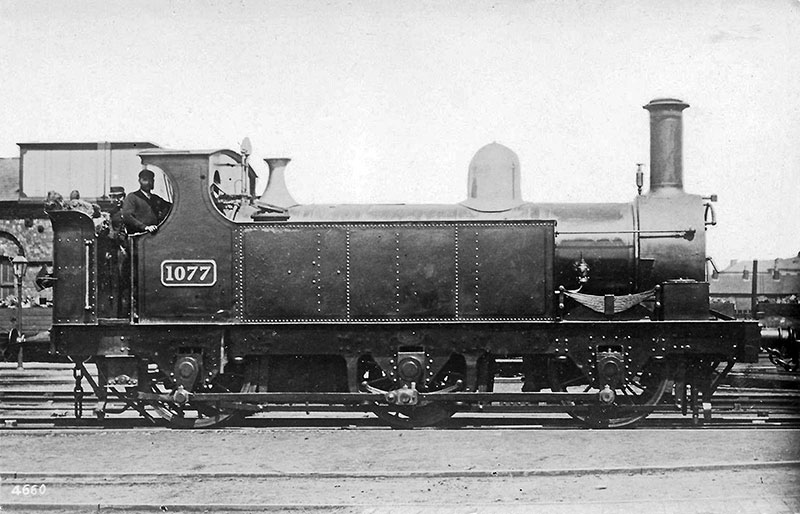
No 1077 of the 1076 class was built as a side tank in May 1870 and became a pannier tank in October 1918. She was withdrawn in July 1931
Undoubtedly the most famous type of all the pannier tank locomotives is the 57XX class. These are another of Swindon’s great success stories. They begin in 1929 under the reign of Charles Benjamin Collett – the then Chief Mechanical Engineer (CME) of the Works. The original impetus for the design lies with the grouping of 1923. This was where the railways of the UK underwent something of a half-way house between a free market and a nationalised industry. While the other companies created were very different to their constituents in many ways, the GWR was a large concern to begin with and only absorbed a range of much smaller companies.

No 1147 of the 1076 class was built in January 1875 as a saddle tank and became a pannier tank in February 1923. She was withdrawn in January 1931
The issue was that these railways they absorbed had a lot of engines. These engines were absolutely worn out. This meant that replacements were going to be required. The first 50 of the 57XXs were interestingly built by the North British Locomotive Works. This is to alleviate pressure on Swindon. There was also another incitement in that the government was offering interest free loans to get men back to work during the Great Depression. There were 50 that were built by the GWR. But the rest of the first 300 were built by outside contractors. These included Armstrong Whitworth, W.G. Bagnall, Beyer Peacock & Co, Kerr Stewart and the Yorkshire Engineering Co.
These initial engines improved on the myriad rebuilds that came before. The fully enclosed cab became a boon for crews. The boiler pressure had been raised from 180psi to 200psi. With that came improved valve gear and this led to a more efficient and powerful machine. While most of the 300 were fitted with vacuum brakes and the ATC signalling safety gear, there were a few in the 67XX series that weren’t.
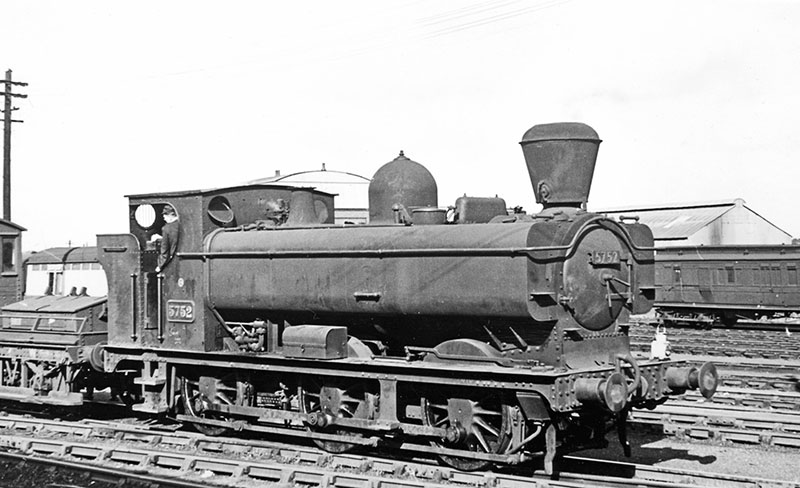
No 5752 was one of the early members of the 57XX class, being built in April 1929 with the earlier type of cab having porthole windows. This photo shows her shunting at Didcot and fitted with a spark arrestor for working in the ordnance sidings
These also had three-link couplings instead of the more usual screw-link couplings. This deliberately limited their use to shunting duties and light freight trains. They also had increased clearance in their axle boxes to allow them to go round even tighter curves in the yards.
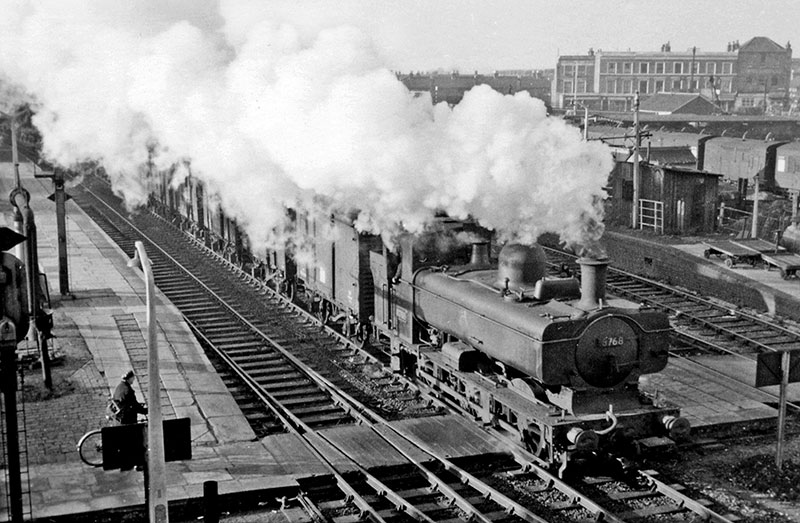
No 8768 was built in December 1933, as a member of the 8750 class. This photo, by Ben Brooksbank, shows her at the head of an eastbound goods train through Southall station on 22 December 1960
The 8750 variant was the next big change. These were in a batch that began construction in 1933. The biggest change visually is in the cab. The 57XXs had small porthole style windows on the front. The 8750s had a taller cab with large front windows and sliding shutters to help afford the crew a bit more weather protection. This was modelled after the ones fitted to the 54XXs mentioned last time. These were the standard type of large pannier built into the 1950s.
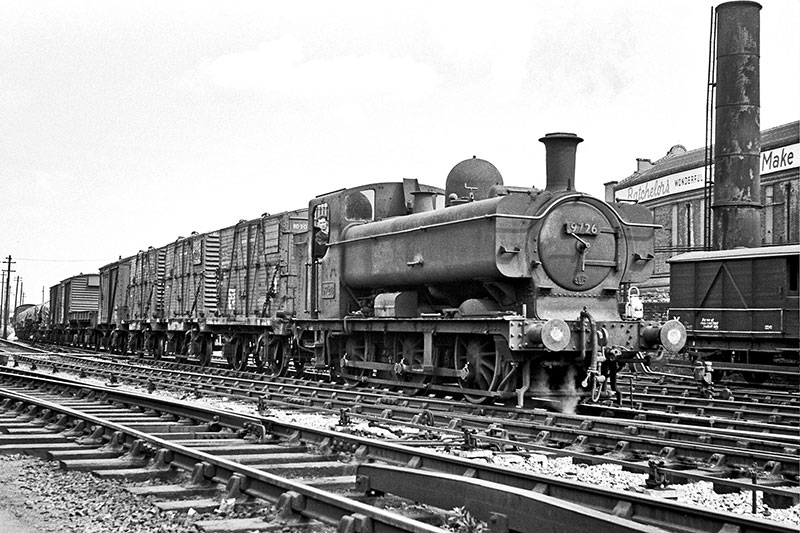
No 9726 was built in December 1934 as a member of the 8750 class. This photo, by Mike Peart, shows her arriving at Southall with a goods train from Brentford in 1962
There was another batch of shunting-only versions and these were also numbered in the 67XX series. The only other big changes in the design were a new boiler where the water for the injectors went into the top of the boiler and not the back as previously. A small whistle shield to prevent noise entering the cab was also fitted in 1936 and a larger version in 1938 followed soon afterwards. Both of Didcot’s resident panniers (Nos. 3650 and 3738) are of this type.
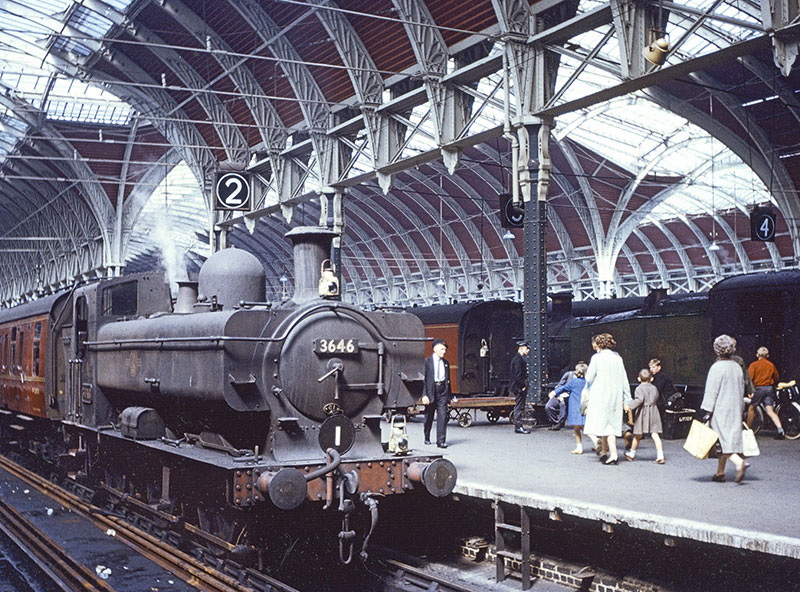
No 3646 was built in November 1939 as a member of the 8750 class. This photo shows her hauling empty carriages into Paddington station in 1964
These engines were found everywhere on the GWR network, being involved with freight and shunting, branch line trains, passenger trains and moving empty passenger trains to and from the carriage sidings. There was however one very specific duty that required a small batch of 11 of them to look very different to the brethren. These were the 9700s. They were specifically designed to work the lines hauling freight in and out of Smithfield Meat Market in London. Parts of this route were underground and as a result the engines were fitted with condensing gear.
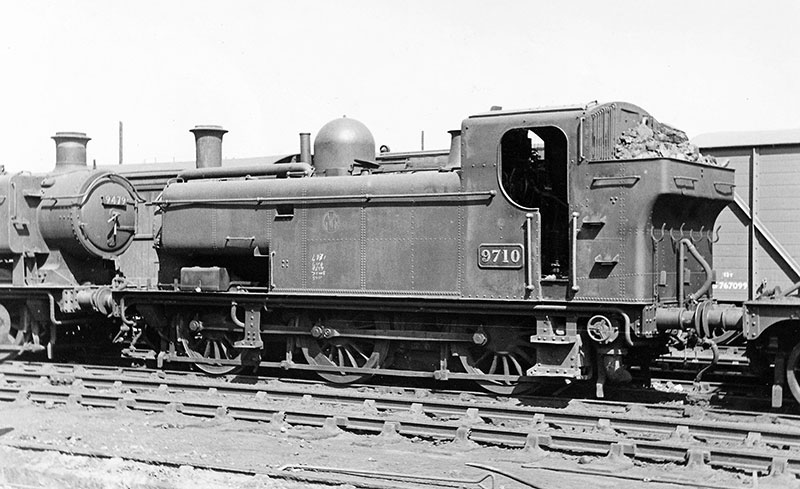
No 9710 was built in December 1933 as a member of the variant of the 57XX class fitted with condensing apparatus for working goods trains through the Underground tunnel to Smithfield Market. This photo was taken at Old Oak Common on 27 August 1961 when she was still displaying the GWR roundel on her tank
Condensing gear is a system where the exhaust from the chimney is directed into the water tanks to be turned back to water. This stopped them blacking out the tunnel with smoke and steam. It does have the issue of heating the existing water in the tanks and the regular steam injectors don’t work well with hot water. To combat this, they were fitted with a small mechanical pump on one side to get water into the boiler. They were also fitted with all the same safety gear required on underground trains to allow them to interface with the signalling system down below.
The ubiquity of the 57XX and 8750 design lead to a grand total of 863 being constructed – an amazing figure in anyone’s reckoning. Some had lives extending beyond the main line railway with a few being cascaded to industrial use and some of the 57XXs being used on the London Underground system. This has led to no less than 16 being represented in preservation including the two that live with us. I seem to have written quite a lot there and we still have the two types of Hawksworth designed large pannier to go so I think we might be into a special bonus pannier Going Loco after ‘Drawings Kev’ tells us about No 3650 next time.
FRIDAY 23 SEPTEMBER
The Universal Saddle Bag? Part 1: Origins
There is a huge and also small elephant in the room that is Going Loco. That is the current non-mention of a certain type of locomotive that was the very backbone of the Great Western Railway’s fleet. Without this humble type, very little would be able to get done. The wagons wouldn’t be shunted, the coaches wouldn’t be at the station for the express locomotive to pull and many of the branch lines would be without motive power. This would be the humble yet amazing 0-6-0 Pannier Tank.

850 class No 1963 was built in November 1889 as a saddle tank, and never fitted with pannier tanks. This photograph was taken at Worcester in 1939. She was withdrawn in January 1943
The origins of this type date way back to the start of the 20th century. As so much Swindon does, the reasons for it are the engineering powerhouse that was George Jackson Churchward. When he became Chief Mechanical Engineer (CME) in 1902, he undertook a study into the very best of steam technology of the time. He selected the most modern or efficient technology to hand and used that to produce a fleet of designs that in one form or another were still effectively being produced into the 1950s.

850 class No 2012 was built as a saddle tank in November 1894. This photograph shows her in the elaborate livery of the time after conversion to a pannier tank in August 1910
One of these technologies he selected was the use of the Belpaire firebox boiler. I won’t go too far into the ins and outs of this as it really warrants its own Going Loco, but suffice to say that it represented a marked improvement on the old round-topped firebox designs then in everyday use. It may well have been massively efficient but it was a more complex shape to make. The angular shape also threw up another problem. Up to this point, it was easy to design a tank engine. For larger machines, you put the water tanks on the sides. For smaller types, a tank shaped like a saddle would go on top of the boiler.
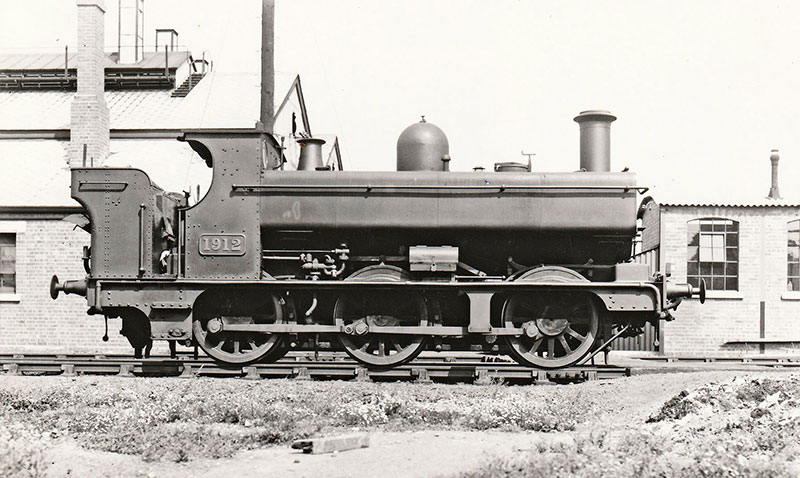
850 class No 1912 was built in April 1882 and converted to a pannier tank in March 1927. This photograph was taken at Didcot in 1935. She was withdrawn in December 1949
Fine when the top of your firebox is round too but if it’s a weird rhomboid type shape then making the saddle fit becomes a bit complicated. A saddle tank offers an advantage other than ease of construction. If you imagine a locomotive with side tanks, these do a really good job of blocking access from the outside to all sorts of different things inside the engine. Great Western engines are particularly affected as they almost all have inside valve gear. A saddle tank has a gap at the bottom between it and the running plate. And that's a bit handy to have.
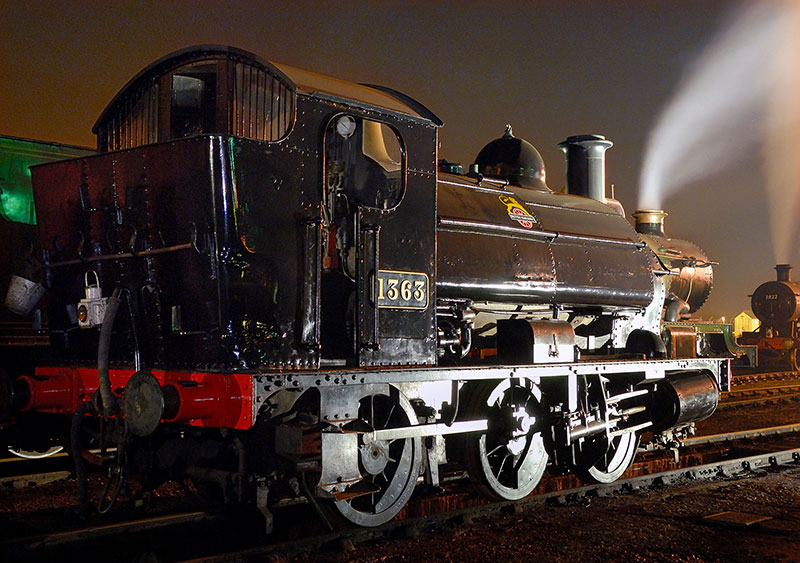
1361 class No 1363, built in June 1910, photographed at night at Didcot Railway Centre in 2007
The only way of maintaining this gap is to hang the water tanks off the sides of a Belpaire boiler but not have them pass over the top of the firebox. These squarer section tanks were seen to mimic the pannier bags on a horse or a bicycle and from there, the name stuck. The modernisation of several earlier classes, such as the 850 and 2021 classes, with Belpaire boilers were among the earliest examples of this design of tank engine that was to become so synonymous with the GWR. In fact it became SO synonymous that almost all locomotives that had saddle tanks were rebuilt with Belpaire boilers and pannier tanks. Preservation reflects this with just absorbed locomotives such as No 1340 Trojan and No 1338 being the majority of saddle tank survivors. The ONLY Swindon-built example is our very own 1361 Class No 1363.
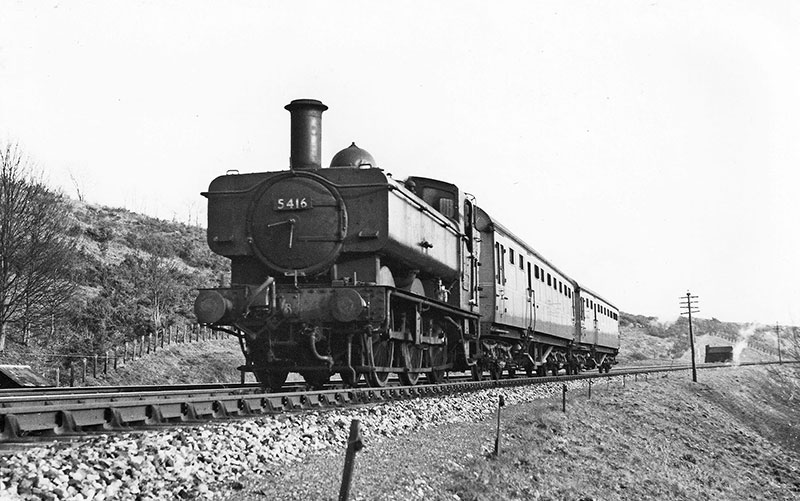
54XX class No 5416, built in June 1932, hauling an auto-train. She was withdrawn in August 1963
Pannier tanks began to be built new from the 1920s onwards so purpose-built panniers really found their place from the reign of Charles Benjamin Collett as CME. There are two basic types of pannier tank locomotive. The small, with a wheelbase of less than 15’ and the large that have wheelbases of more than 15’. One of the small pannier types sadly missing from preservation is the interesting 54XX. This was a small pannier based upon the 2021 class engines. In fact, a prototype was constructed using one of them as a basis. The 54XXs had an interesting feature – the same 5’ 2” diameter driving wheels as the 48XX 0-4-2 Autotanks. The 54XXs were also auto fitted and their large wheels made them ideal for accelerating fast for the inner suburban routes in and out of Paddington.

64XX class No 6430, built in March 1937, at Plymouth North Road with an auto-train for Saltash in 1962. She is now preserved on the South Devon Railway. Photograph by Mike Peart
There were two smaller wheeled versions of these designs too. Instead of the larger 14XX size wheels, they had a smaller 4’7½” drivers. This has the effect of ‘lowering their gearing’ so to speak. Their top speed was lower than their 54XX cousins but their pulling power was increased. This made them ideal for the more hilly routes and goods work they were designed for. They came in two variants. The 64XX class was auto fitted just like the 54XXs and the 74XX class wasn’t!
There are survivors from this merry band and they are all 64XXs. Two of them are associated with the South Devon Railway. No 6412 is owned by the railway but is currently on hire to the Chinnor and Princess Risborough Railway at the time of writing. The other, No 6430, is privately owned and operated on the South Devon Railway. The Bodmin and Wenford Railway is home to No 6435 and this engine comes to the end of its boiler certificate this year.

16XX class No 1616 at Severn Bridge station on 9 August 1951. She was built in December 1949, and withdrawn in October 1959. Photograph by Ben Brooksbank
The two other types of purpose-built Small Pannier consist of the 16XX class and the 1366 Class. The 16XX class were essentially a new version of the then ancient 2021 class machines. They were masterminded by the last CME of the GWR, Frederick Hawksworth. They were relatively short lived compared to many Western machines as they arrived late in the day and the last of the 70 built was completed in 1955 but the end of steam caused their withdrawal to begin in 1959. It was complete by 1966. Fortunately, No 1638 is still with us and lives far from her intended home at the Kent and East Sussex Railway.
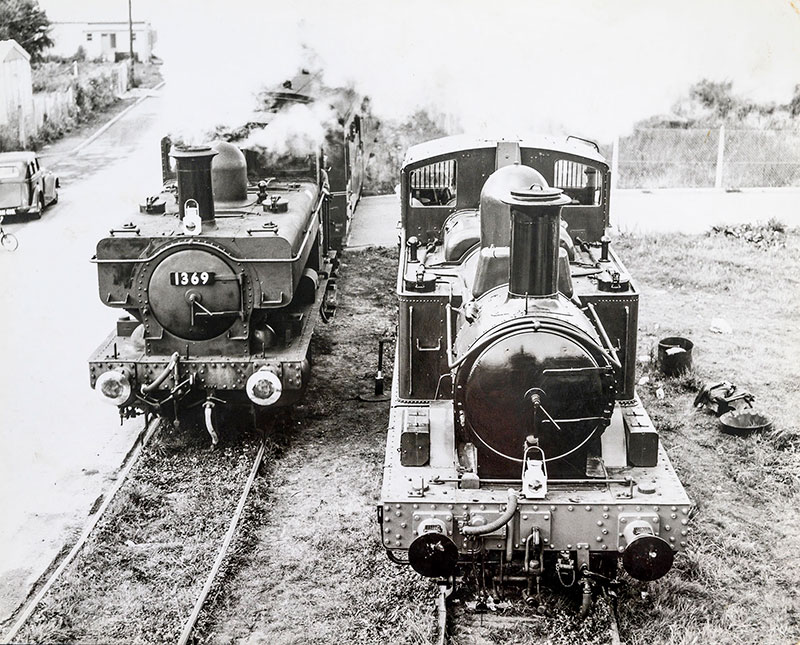
1366 class No 1369, built in 1934, when first preserved at Totnes in October 1965, in the company of 1466
The last is of interest to us. The 1366 class was essentially a modernised version of the 1361 class saddle tank design, to which our illustrious No 1363 belongs. This short wheelbase and outside cylinder design was itself based on a far older locomotive built for the Cornwall Minerals Railway in the mid 19th century. They were, like the 1361s, a go-anywhere sort of design and did get about quite a bit. They became that one thing a little blue loco always wanted to be – a really useful engine. Thankfully, one of these excellent machines survives. No 1369 is also based at the South Devon Railway and it is our hope that she will meet up with No 1363 some day.
That will do for today. I’ll deal with the development of the Large Panniers next time and the week after that, Kevin of drawings fame has agreed to have a chat with us about his charge – one of the two resident 8750 class Panniers at Didcot – No 3650.
Until next time…
FRIDAY 16 SEPTEMBER
The Pioneer's Progress – Part 7
Well, it’s been a while since we caught up with the loco that started it all, No 1466. There has been a good bit of progress since then and my good friend Phil has put together a few words on the goings on. Without further ado, take it away Phil…

1466 with a train at Ashburton, Devon, setting off towards Totnes on 6 September 1958. Photo by Roger Joanes
Thanks Drew! Well, since my last update its fair to say we've been very busy with Ryan & his team at West Somerset Railway (WSR) picking up the pace. There’s been a myriad of jobs completed, plus various NDT* inspections and a regular boiler inspection from BES***.
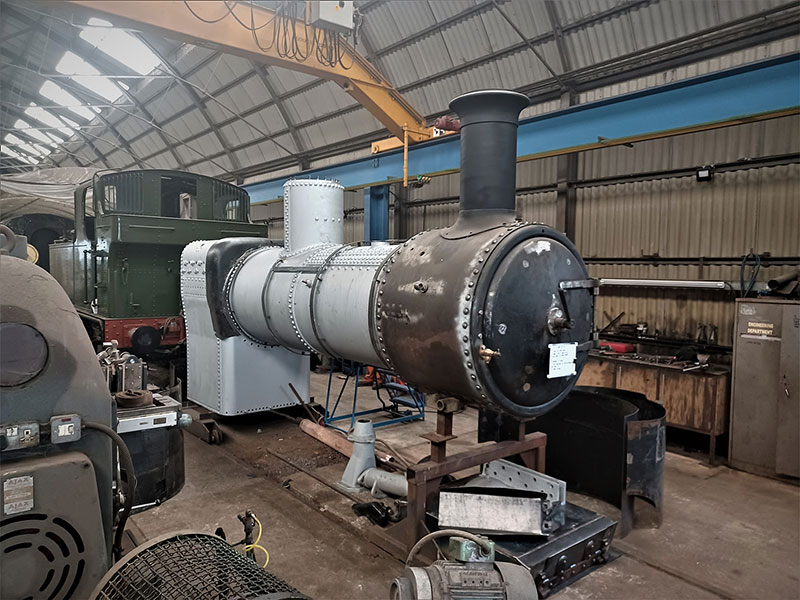
The boiler taking shape after receiving new crinolines. Photo by Phil Morrell
With the previously mentioned riveting escapade complete, Ryan and his team set about fitting the new handrail mounts and stanchions. The boiler also received new clack mounting pads, and having the riveting complete also meant our welding contractor Ian Massey was able to progress and undertake the final seal welds to the boiler. Various Non-Destructive Testing (UT & MPI**) was carried out to all the steel welding that has taken place over the past few months and I’m glad to say everything passed with flying colours. We’ve also had our latest boiler inspection by BES who monitor all the progress and work throughout the overhaul, whom again are very happy with the work being carried out.
As previously mentioned, we’ve had a complete new smokebox manufactured (new barrel, sacrificial plate, inner and outer door pressing and front door-ring pressing which were made by SDRE****) along with a new ashpan due to the originals being very tired and work worn. Having done this, it will theoretically not need any remedial work to it, in the near to medium future. Great news for Didcot’s loco maintenance team! Harry from WSR – who is often found amongst the railway’s Mk1 coaches and many paint brushes – took on the job of overhauling various pieces of cladding covers of 1466 and he has done a fabulous job of them.
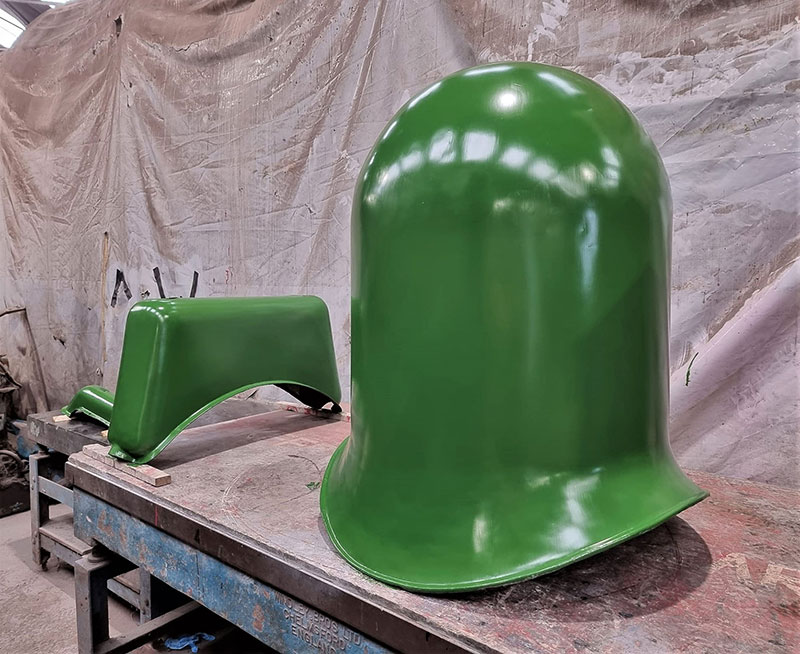
The dome and clack cover receiving some TLC. Photo by Harry Spencer
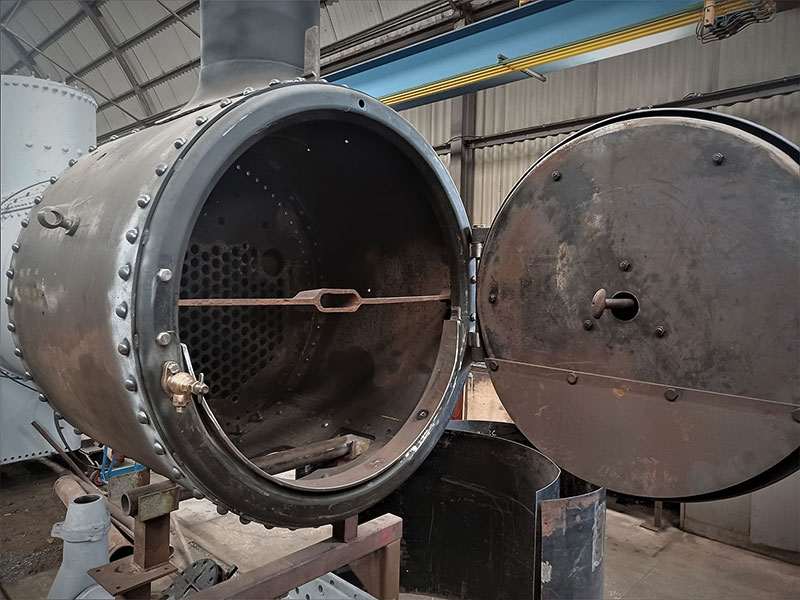
The new smokebox. Photo by Phil Morrell
As well as that, there has been a plethora of other work:
1. The steam dome has received a light ‘skim’ (a machining operation to establish a new, smooth surface) after being re-faced and the steam dome itself re-studded.
2. A new set of crinolines (cladding supports) have been made.
3. A new whistle shroud has been manufactured after finding the original being in worse condition than originally thought.
4. The steam collector and its associated parts have been overhauled.
5. A new petticoat (a shroud in the smokebox to direct the exhaust blast up the chimney) has been sourced & delivered.
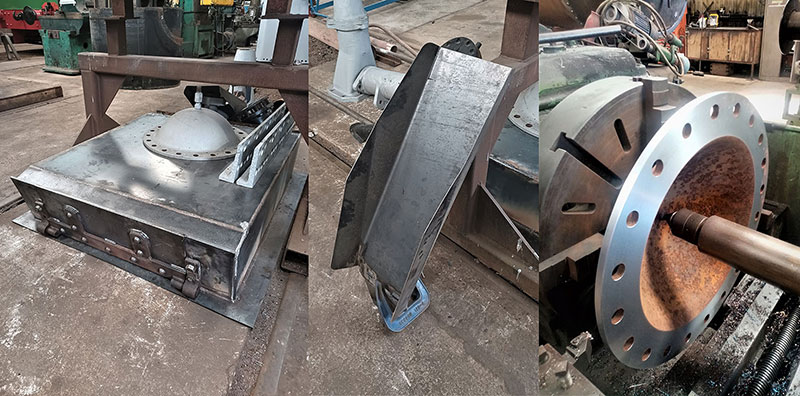
Left to right – the newly-manufactured ashpan: the new whistle shroud: the steam dome being re-faced. Photos by Phil Morrell
Copper?
No, not a visit from an officer of the law…
You may remember that previously we have ordered a new copper tubeplate and doorplate for the inner-firebox. This is progressing – in that the copper plates have been made – but we have unfortunately hit some delays that are out of our control. With one of the plates having arrived in the UK, we are still awaiting the second. It is hoped that these should arrive with us in pressed form by the end of September / early October.
In the meantime, whilst the current orders are in the process of being finished, work to No 1466 will now slow whilst we await the arrival of the copper firebox components. We are utilising the time to source all the other necessary materials and amenities that are left to get (such as materials for copper and steel side stays), so that everything is essentially ready to go upon arrival.

1466 by the water column at Moretonhampstead with a train for Newton Abbot
If you would like to donate to this wonderful pioneering locomotive, please follow the link below:
As always, any donations small, medium or large are always gratefully received; In a restoration such as this, every £1 counts and can make such a difference to enable us to finish her overhaul. We’re slowly approaching our last big hurdle, so do stay tuned. Until next time folks…
Thanks Phil! It seems we are edging ever closer to that double heading run between No 4079 Pendennis Castle and No 1466 that Phil and I keep threatening! We think it will be a worthy salute to welcome the return to traffic to this most important machine for the history of the Great Western Society and steam preservation in the United Kingdom as a whole. See you all there.
Welcome to abbreviation corner…
* Non-Destructive Testing.
** Ultrasonic Testing and Magnetic Particle Inspection.
*** British Engineering Services.
**** South Devon Railway Engineering.
FRIDAY 9 SEPTEMBER
A Bearly Believable Tale?
Last Saturday I was both duty manager and shunter for the running day at Didcot. Towards the end of the day, I went to the branch so I could be on time to get the stock put away and get the loco back on shed so my crews could go home. I turned up a bit early and was allowed to sit in the cab of Class 14 No D9516 while the last few runs ticked down to home time. Because I asked questions about how the thing worked, I was handed the clipboard kept in the cab which has diagrams and history on it as well as the start up and shut down procedures. Hence today's blog! Let's set off on an ursine* adventure…
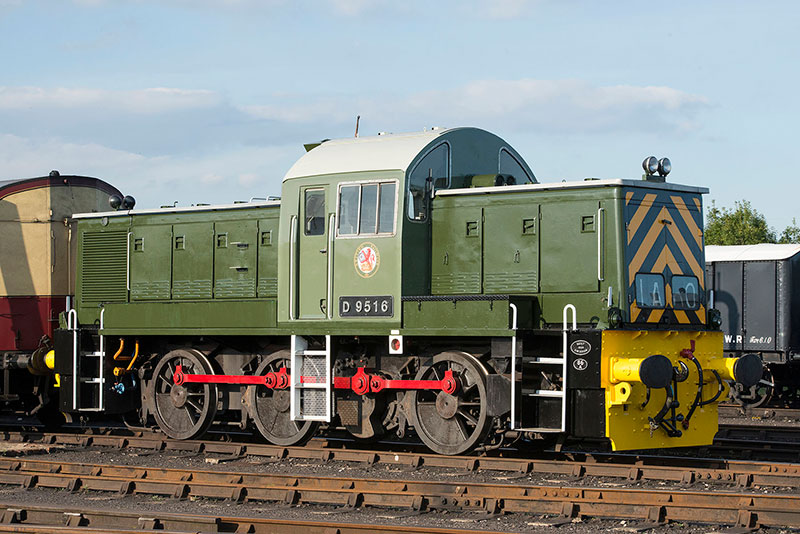
D9516 at Didcot Railway Centre
The end of steam came fast to the Western Region of British Railways. It had started in the mid to late 1950s but by the mid 1960s it was all over. As part of this process, at this time it was seemingly obvious to all that the little evolutionary niches that had been filled by over a century of steam locomotive development would need to be filled with modern traction replacements. This went from the mighty express passenger and heavy freight locomotives to the smallest shunter. One of the tasks that needed covering was trip working (taking goods vehicles from shunting yard to shunting yard) and short distance freight trains. Swindon was willing to oblige!
Despite being nationalised back in 1948, there was still an independent attitude that purveyed the Western Region (WR). You don't just remove a century or more of tradition and culture in a few years. The WR therefore tackled modernisation in its own way. Electrification of the route of the former GWR wasn't on the cards – in fact it was only undertaken in the 21st century. The majority of non-electric areas went for the either diesel-mechanical power (an engine and a gearbox, just like a car) or diesel-electric. This latter method is a diesel engine, driving an electric generator to drive electric motors on the wheels.

Western Region diesel-hydraulic locomotives at Old Oak Common in 1965: from left a Class 22 ‘Baby Warship’, a Class 52 ‘Western’ and a Class 35 ‘Hymek’
The Western Region used diesel-hydraulic motive power. This is where the engine drives a pump that takes the form of a large propeller type affair. There is another propeller facing the one driven by the motor. As the first propeller spins, the flow of oil over the second causes it to turn too. The second propeller drives a final gearbox and this drives the wheels. There were a number of different diesel-hydraulic locomotives built. The famous ones being the Class 52 Westerns, the Class 41, 42 and 43 Warships and the Class 35 Hymeks. Less well known was the Class 22 Baby Warships and the diminutive Class 02 0-4-0DH shunters.
Outside of a few prototype and industrial locomotives, the other diesel-hydraulic locomotive that was built in anything like a reasonable number is the Class 14. The (then) modern answer to trip and short distance freight working. At the heart, there is a Paxman 6 cylinder Ventura 6YJXL diesel engine rated at 650 bhp. This is connected to a Voith L217U hydraulic transmission. A driveshaft leads the power down to the final drive gearbox which is connected to the jackshafts that are mounted outside the loco frames, under the cab. Instead of sporting bogies like the majority of the other WR diesel-hydraulic machines, they have a fixed coupled 6 wheel design and the rods connect the wheels to the jackshaft.

Class 14 No D 9513 brand new at Swindon Works on 27 September 1964. This locomotive is now preserved on the Embsay and Bolton Abbey Railway. Photograph by Phil Kelley
Externally, they are quite unusual looking beasts from the point of UK design practice. The cab is offset towards one end. It is mounted up high and affords the crew a really good view. There are dual controls making it possible to drive the engine from either side. Really useful in the shunting and trip work role it was designed for. The original order at Swindon was for 26 but this was increased to 56 in 1963. They were built at Swindon between 1964 and 1965.** One who wasn't impressed by the latest thing was the then erecting shop foreman, Mr George Cole. He is quoted as saying: “We've built The Great Bear*** and now we're going to build a Teddy Bear!” The name stuck and they are known to this day as Teddy Bears.
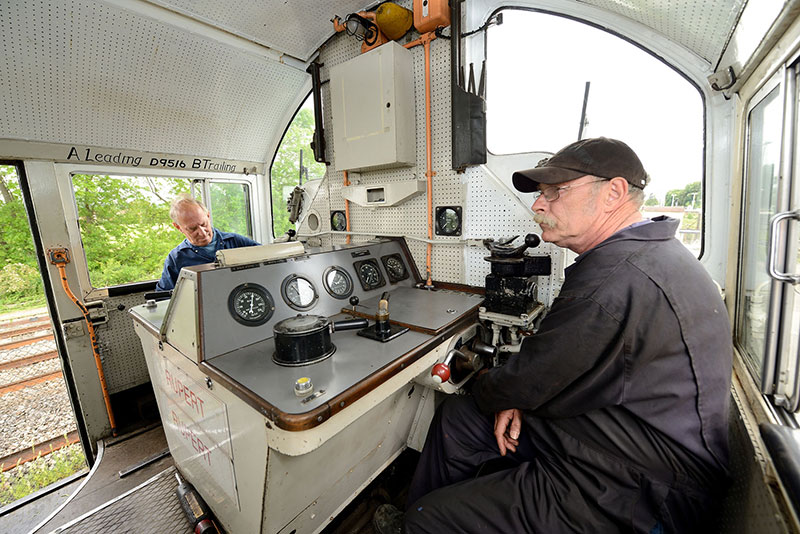
Inside the cab of D 9516, with John Crane on far side of driving desk and Kevin Dare this side
They were efficient, reliable and well built. And a total failure. So how can this be? It wasn't the engineering that let them down but the changing times and politics. They originally all lived on the WR. As their work dwindled, some went to Hull on the Eastern Region to work the docks there. This was a silly move in many ways as the tasks they were set were too much for just one Class 14 and working them in pairs was the only uneconomic option. The 33 locomotives that went north, didn't last long and were all withdrawn by 1 April 1968. No joke. Back on the WR, the roles they had been built for were fast disappearing. Rail freight changed from being a carrier of all things to being a carrier of bulk things only.
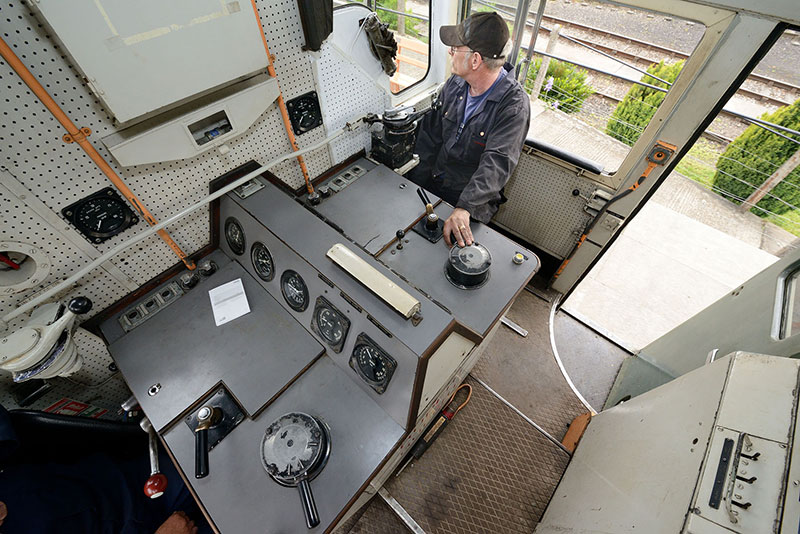
The cab of D9516 showing the dual controls on the driving desk
The Class 14s, rather than replacing the steam engines, didn't last any longer than them. Disposals of the class started in mid 1968 and unbelievably some of these engines were simply scrapped with less than 5 years of service under their belts. The frankly scandalous waste of public money at this time is vast. Steam engines built for a 40 year service life and withdrawn at less than 5. Their diesel replacements either suffering the fate of the Class 14s or being engineering nightmares that really shouldn't have been ordered straight from the drawing board.
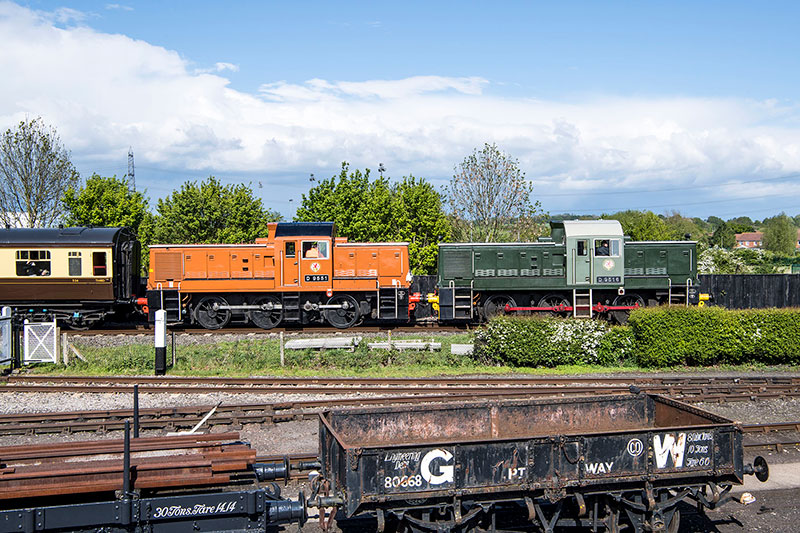
D9551 and D9516 double-heading during 9551’s visit from the Severn Valley Railway in 2019
Some of the Class 14s didn't succumb to the march of progress of which they were supposed to be the vanguards. Ours is a case in point. No D9516 was completed in October 1964 but was out of service with the WR by 1966. It was one of the machines to take the trip to Hull but this too ended by April 1968. No D9516 ended up working for industry. Stewarts & Lloyds Minerals purchased the engine and renumbered her to No 36. She worked at both Buckminster Ironstone Quarry and later BSC Corby.
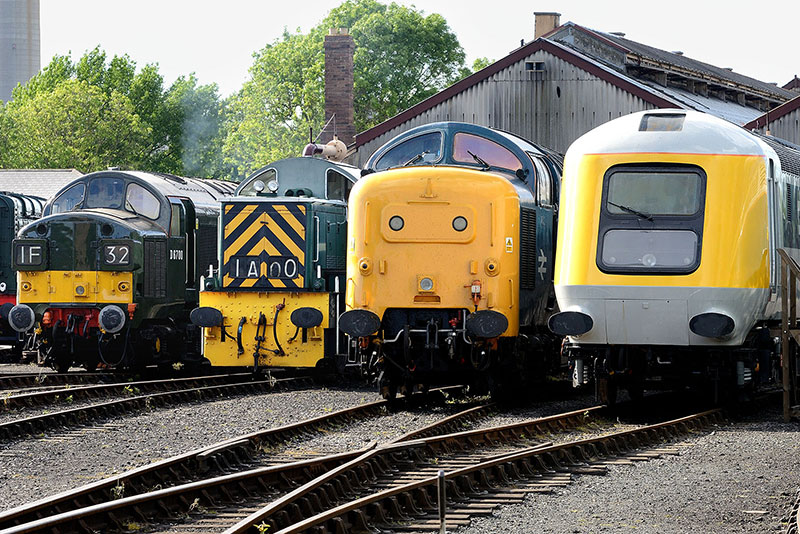
D9516 with diesel-electrics at Didcot in 2014 – a class 37 No D6700, Deltic No 55 002 and prototype HST power car No 41 001
The late Gerald Boden bought the loco in 1981 and it went via the Nene Valley Railway to the Wensleydale Railway in 2011. We bought her in 2014 and she arrived at our home shed in May of that year. Ever since she has entertained our visitors alongside the other engines in our stable. While it only vaguely looks like a steam engine(!), its history as part of the last gasp of Swindon independence before it was subsumed into British Rail Engineering, and eventually closed in 1986, more than earns No D9516 her place in the collection.
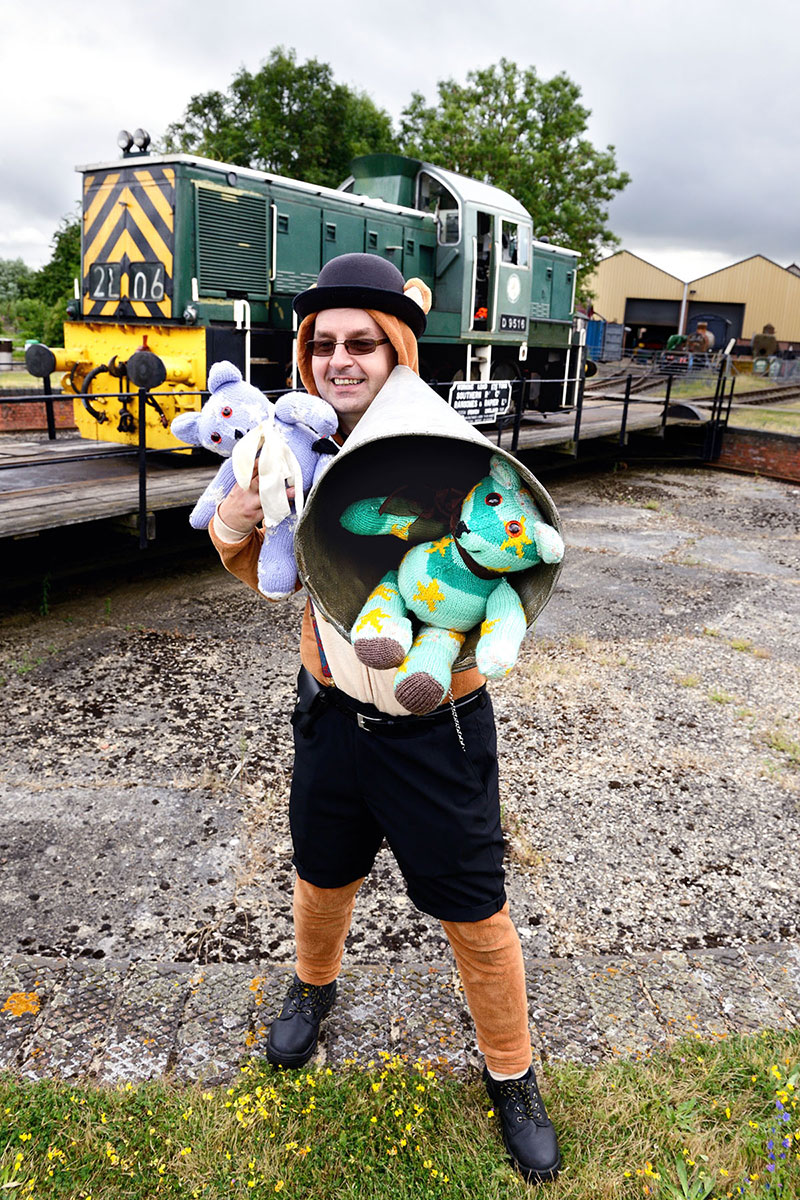
Scott Wilgrove at Didcot’s Teddy Bears’ Picnic in 2014 with the Teddy Bear on the turntable behind
*Ursine – bear like.
**There are some great pictures of No. 4079 Pendennis Castle being restored in the mighty A Shop of Swindon Works at this time, with Class 14s being built all around her.
***No. 111 The Great Bear. The only 4-6-2 or Pacific type locomotive the G.W.R. ever built.
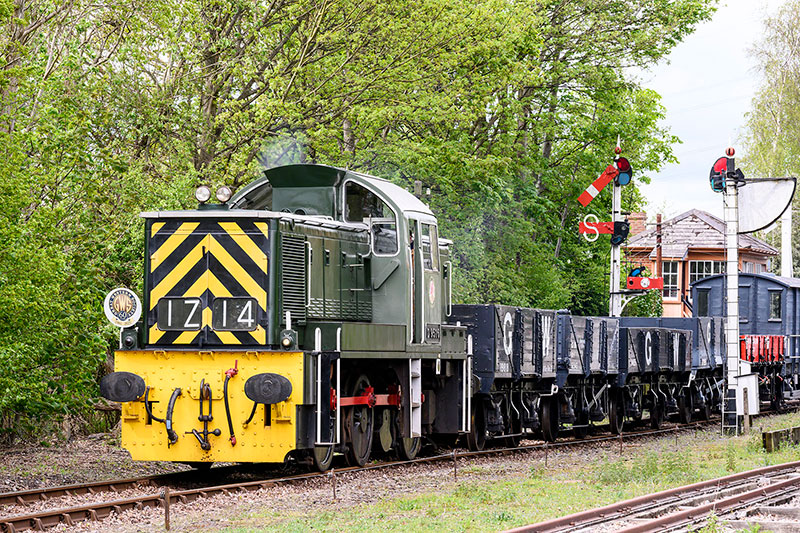
D9516 hauling a goods train at Didcot in 2021
FRIDAY 2 SEPTEMBER
Welcome to 10 River Gardens
There are two reasons for me doing this blog now. Firstly, I mentioned that it might be a good idea in my ten favourite things / Blog 100 list last week. Secondly, the detail needed to fill up a blog correctly was published in the Society's Journal, Great Western Echo, last month too. Which gives me the perfect opportunity to ask if you are a society member? If not, why not? It opens up the possibility of coming to Didcot to volunteer. Free entry on most open days and so on!
So, in the truest fashion of TLDR* here's the clip notes version!
The coach in question is Family Saloon No 2511. It's probably worth explaining that title. In the modern world, trains are what is known as ‘fixed formation’. This means that the vast majority of rolling stock travels as a fixed set, only being uncoupled for maintenance reasons. The amount of spare rolling stock not in very regular use is kept to a minimum as it’s cheaper to do so. Train vehicles also tend to be generalists too. Look at the modern container train to see that. Passenger trains today are fixed multiple units that come as a set, its seating capacity determined long before you travelled by engineers and statisticians.
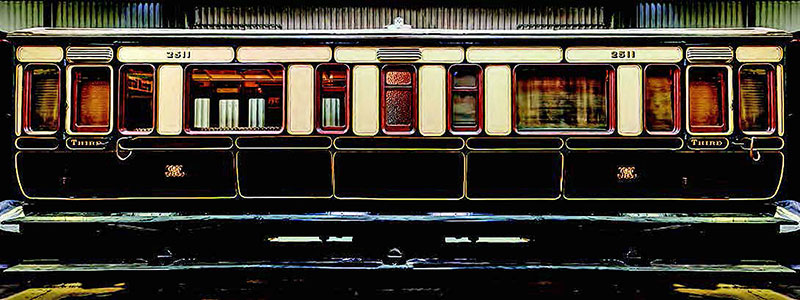
2511 as exhibited in the carriage shed today
The steam era railway wasn't like that. They held far more spare rolling stock for a start and that rolling stock was more specialised. The rolling stock was built for, in some cases, occasional use. The family saloon is a prime example of this. The idea here was that if you were reasonably well off, you could have an extra private coach added to the train. This could be done for any destination. This was a common practice for big events such as the races at Cheltenham or Ascot, or the Henley Regatta. The largest and most glamorous of these types had compartments for the family as well as extra areas for servants and even had kitchen compartments.

2511 as first seen as 10 River Gardens in 1969. Understandably, the Society members didn't connect at first to what it was, as they went past in the boat
No 2511 first saw the light of day way back in 1894. It was built as part 54 vehicles of lot 720 and to diagram G.20. It was then a vehicle of some modest luxury. It has two compartments fore and aft with the centre section having the lavatory (with sink to wash hands in) and a water closet (flushing directly onto the track). There are no connecting corridors to couple up with other vehicles in the train but this wasn’t unusual for the era. The interior was originally quite simple, using a painted wood effect on the interior panelling. Also in common with its contemporaries, it was gas lit from the outset. The length and weight of the vehicle meant that it was provided with a 6-wheel chassis instead of the more usual 4 wheels of non-bogie coaches.
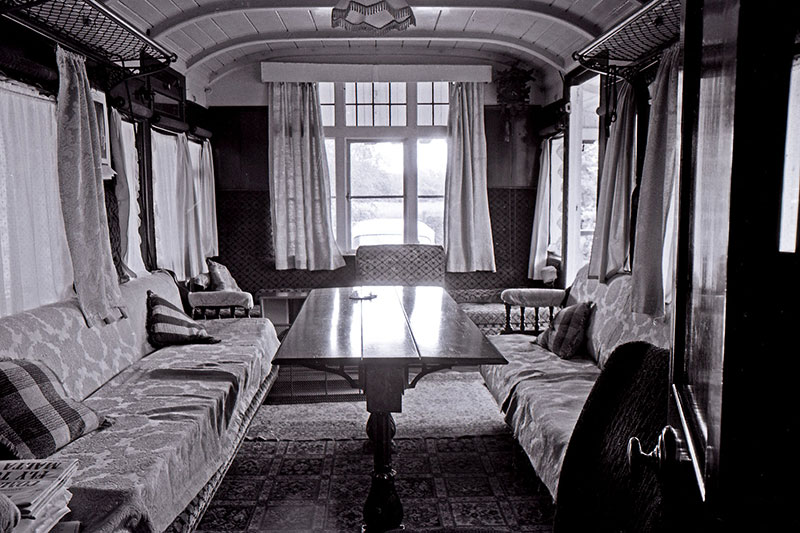
The interior of 2511 in use as a house. The window was inserted in the end wall overlooking the Thames, without disturbing the original framework of the vehicle
It went through a few changes in its life. In 1899 it gained gas heating which gave the vehicle a bit of autonomy away from the trains. It could be pre-heated and then added to the train as required rather than having to rely on a steam locomotive to supply the energy. A company-wide renumbering saw all saloons of this sort put into the 9000 series with No 2511 becoming No 9317. We know that at this time it was used in and around Weston-super-Mare as it was allocated there in 1909. A further refit in 1911 was the largest it had. The biggest change technically was the addition of incandescent gas lights. This uses a mantle – a fabric mesh impregnated with a metal oxide – which glows bright white when heated, thus improving the illumination.
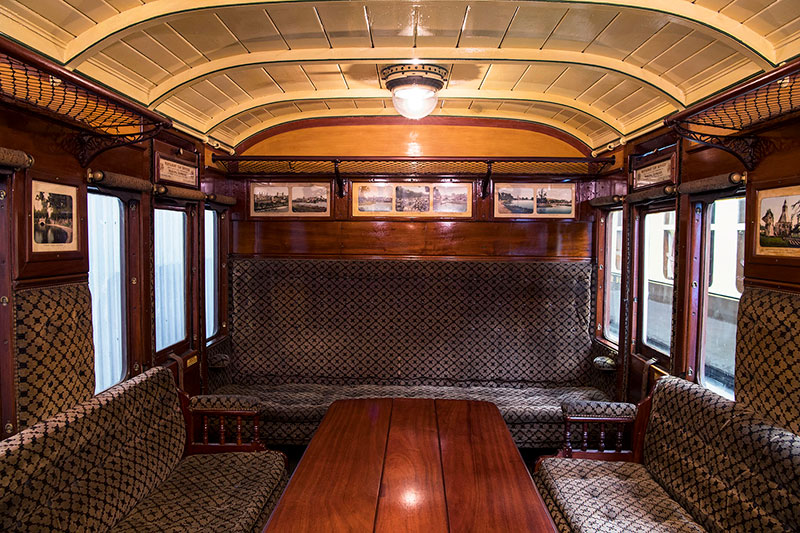
The same view inside 2511 today
The big change was the interior. It went from the somewhat Spartan original into a full blown tour de force in mahogany and French polish. The walls have hand tinted photographs and the seats provided with a rich upholstery. No 9317's last refit was done, we think, sometime in the 1920s but after that the vehicles fortunes changed. Smaller passenger vehicles of the 4 and 6 wheeled varieties were being phased out and by 1937 the end had come for this vehicle. So, how come it's still here?
A common practice at this time was to use old 4 and 6-wheeled coach bodies as the basis for prefabricated houses. A great idea of you think about it. Especially for the family saloon. It's already got a lounge and a bathroom… This is what happened to No 9317. It was transported to Purley-on-Thames, near Pangbourne and became No 10 River Gardens! One of the saloon ends was converted to become two bedrooms. The far end wall of the lounge saloon received a window overlooking the river Thames, using the original framework with glass inserted between the timbers, but otherwise remained just as the GWR left it. Down to the last detail.

Demolishing the structure around 2511 before the move to Didcot in 1972
The other factor that marked out this vehicle for preservation was a roof that completely covered the body. Most of the time when these conversions are carried out, the coach bodies are left to fend for themselves in the weather. This means that they deteriorate. The roof on No 9317 stretched far out around the vehicle making a veranda. This kept the rain off and kept the body safe and dry. And that's where it sat. For decades…
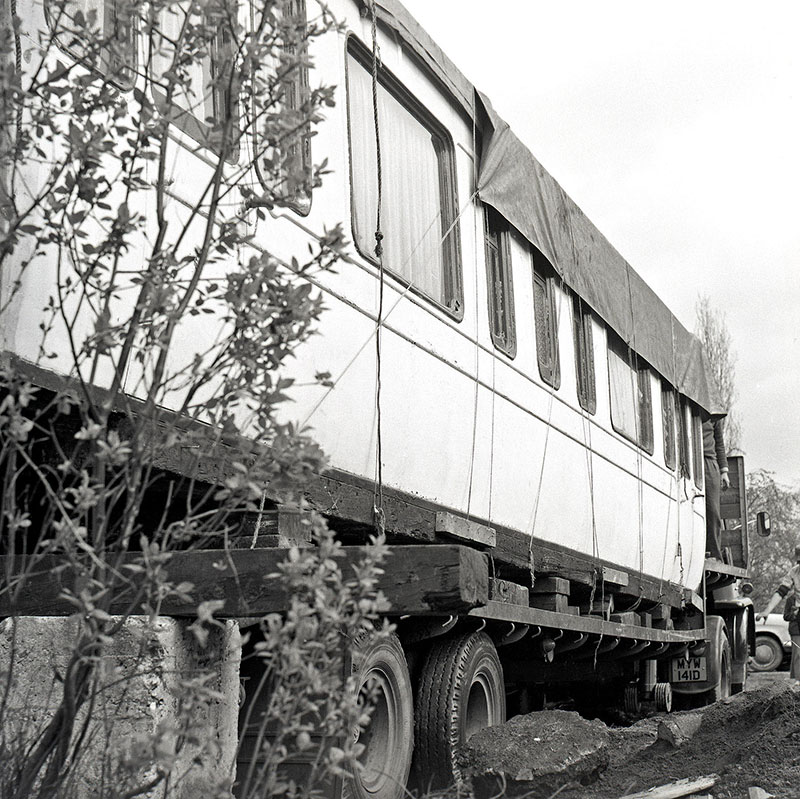
The lorry backed under 2511 for the road move to Didcot
…until a number of GWS members hired a boat in 1969 and went on a cruise on the Thames. This is when they started spotting old Dean coach bodies being used as houses. Whilst looking at the ex-carriages, an old lady was spotted and she told the members that her friend's house still had all the seats and everything else in place. It sounded too good to be true. The Society's then secretary Kevin McCormack and our very own Photo Frank managed to convince the then resident to let them take a look inside. They were stunned!
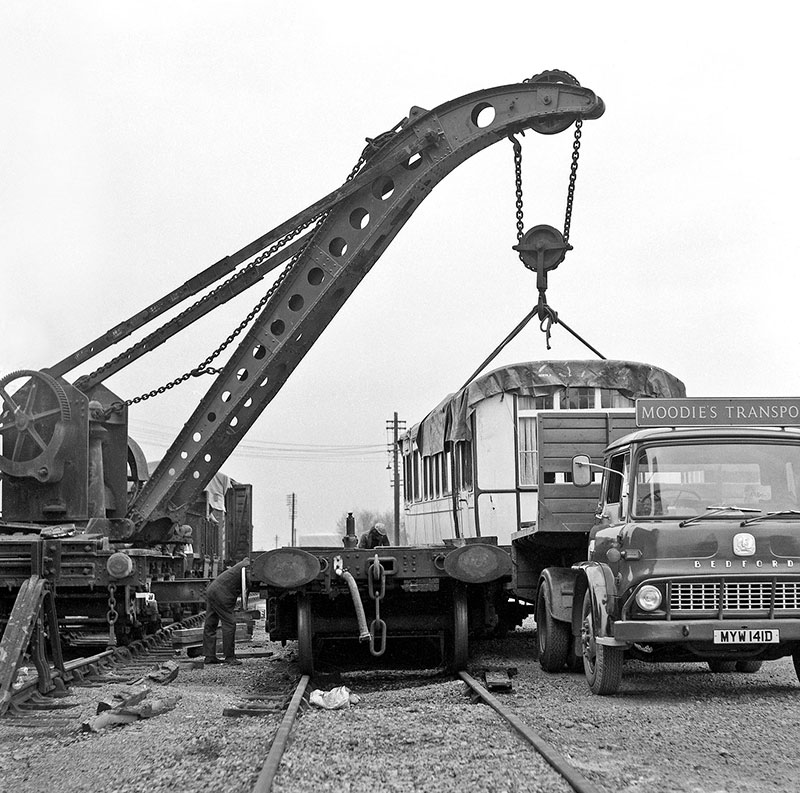
Transferring the body of 2511 from Jo Moodie's transport to a rail wagon in the Provender yard at Didcot
Needless to say, the society wanted to preserve it and eventually the plot in which the coach sat was sold and the new owner wanted to build a new house on the ground it occupied. At the time, 1972, the £200 asking price was out of the Society’s reach and in order to secure it, Kevin McCormack use an inheritance his mother had received to buy the coach. A further £25 secured the help of Jo Moodie and his transport firm. They got it to the railway at Didcot and eventually it was transported to the Railway Centre.

2511 on its temporary wheels for the move to Didcot Railway Centre in 1972, watched over by the much mourned Provender building. The six-wheel chassis was later sourced for 2511
The chassis was replaced with the discovery of 6-wheel tool van No DW 109 at Tavistock Junction, Plymouth. This was secured and the body swapped to once again complete this historic coach. The missing parts of the interior have been slowly collected and one end and the centre lavatory and water closet is now substantially complete. The outside is also in its original livery with its identity of No 2511 restored to it. The coach is an amazing survivor and a massively important piece of GWR history. The rarity of having an interior of this age in anything like its original condition is quite remarkable and we are pleased that the coach continues to be displayed in a prominent position at Didcot. So, next time you visit, make sure you visit 10 River Gardens, Purley-on-Thames. Without leaving Didcot…
*Too Long Didn't Read.
Didcot Railway Centre Newsletter
Stay up to date with events and what's going on at Didcot Railway Centre.
You may unsubscribe at any time. We do not share your data with 3rd parties.